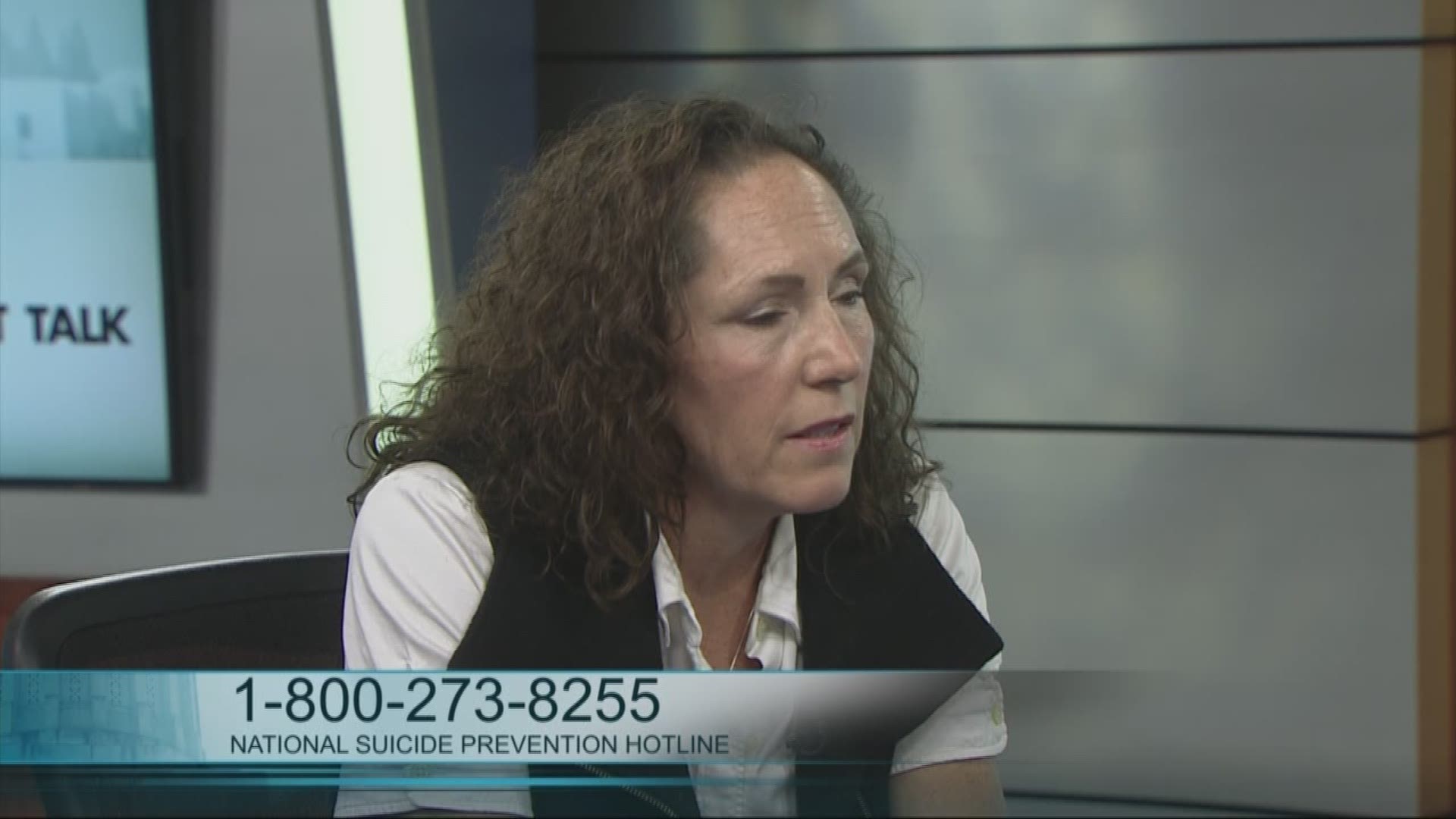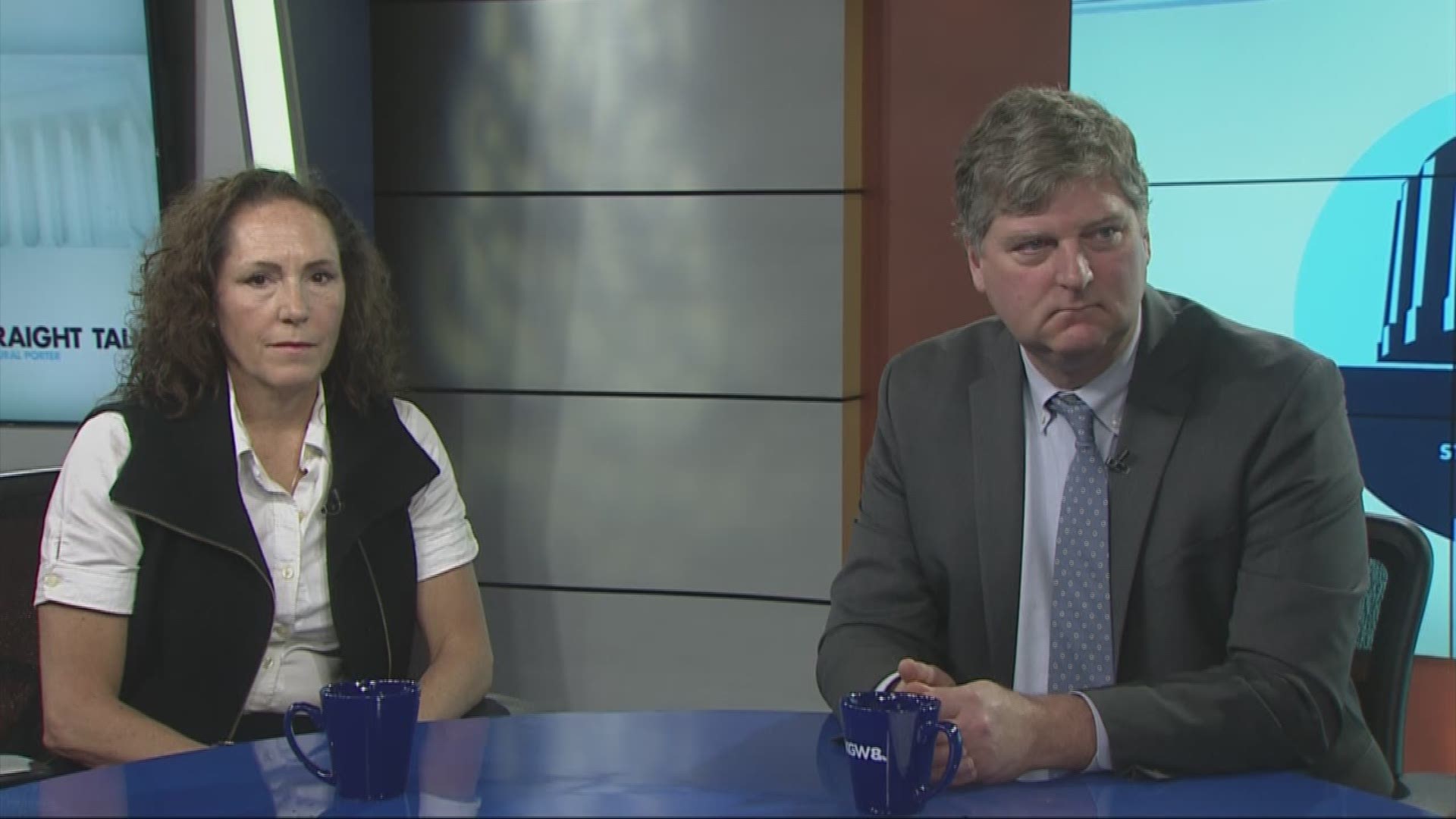Editor’s note: This month, newsrooms across the state are highlighting the public health crisis of death by suicide. Our goal of “Breaking the Silence” is to not only put a spotlight on a problem that claimed the lives of more than 800 Oregonians last year, but also examine research into how prevention can and does work and offer our readers, listeners and viewers resources to help if they – or those they know – are in crisis.
Most of our work will be published and broadcast April 7-14. The participating media outlets are using a common set of data and have loosely coordinated their coverage in an effort to avoid duplication and better amplify all of our work. When possible, we will promote each other’s stories, but all of them can be found on breakingthesilenceor.com
PORTLAND, Ore. -- When Kimberly Repp saw how high Washington County’s suicide numbers were each year, she vowed that she would do something about it.
Repp is the supervisor of the county’s public health program and the county’s epidemiologist, which makes her responsible for tracking and responding to diseases that affect public health, such as annual flu outbreaks.
She never imagined that she would be investigating suicide.
But in the mid-2010s, Washington County had one of the highest rates of suicide in Oregon.
The number of people dying by suicide in Washington County began climbing dramatically in 2009. That year, 55 people died by suicide. The numbers continued to climb until they hit a peak of 96 people dying by their own hand in 2012, or approximately 18 per 100,000 people. That is well above the national average of 13 per 100,000.
“That’s not just kind of bad,” Repp said. “That’s just … astronomically bad.”
Starting in 2014, Repp began accompanying the county’s death investigators to death scenes to see what clues or evidence would be present in the room where a person was last living. She visited more than 200 scenes in a two-year period.
From that, she developed a list of 46 risk factors that contributed to a person’s death by suicide. Since 2015, those risk factors have helped county officials expand the types of people and places that Washington County and partner organizations target for suicide trainings, prevention and intervention efforts.
As a result, the county’s suicide rate has fallen by 40 percent in three years.
“That data has given us the information we need to make tangible interventions in our community,” Repp said.
Among the list of risk factors are what one might expect: depression, social isolation, and problems with drug addiction or family or money.
But one leaped out to Repp, and others – a quiet social problem that drastically affects increasing numbers of poor people in recent years: eviction.
Eviction was a prevalent risk factor in 104 suicides in Washington County between 2014 and 2018. That included people experiencing an eviction in the last two weeks of their life or in recent years.
“I was really, really surprised by how prevalent eviction, as a crisis, and ongoing housing issues were … directly impacting our suicide rates in Washington County,” Repp said.
In response, Repp worked with the Washington County Sheriff’s Office, which delivers court-ordered evictions, to have the phone number for a crisis line printed at the top of all eviction paperwork that a renter is given.
Members of the Washington County Mental Health Response Team, which intervenes when people are experiencing mental health crises, also will go with a sheriff’s deputy who is serving an eviction if they know that the person is likely to be extremely upset.
Since the intervention, those who die by suicide in Washington County with eviction as a risk factor has fallen by 25 percent each year.

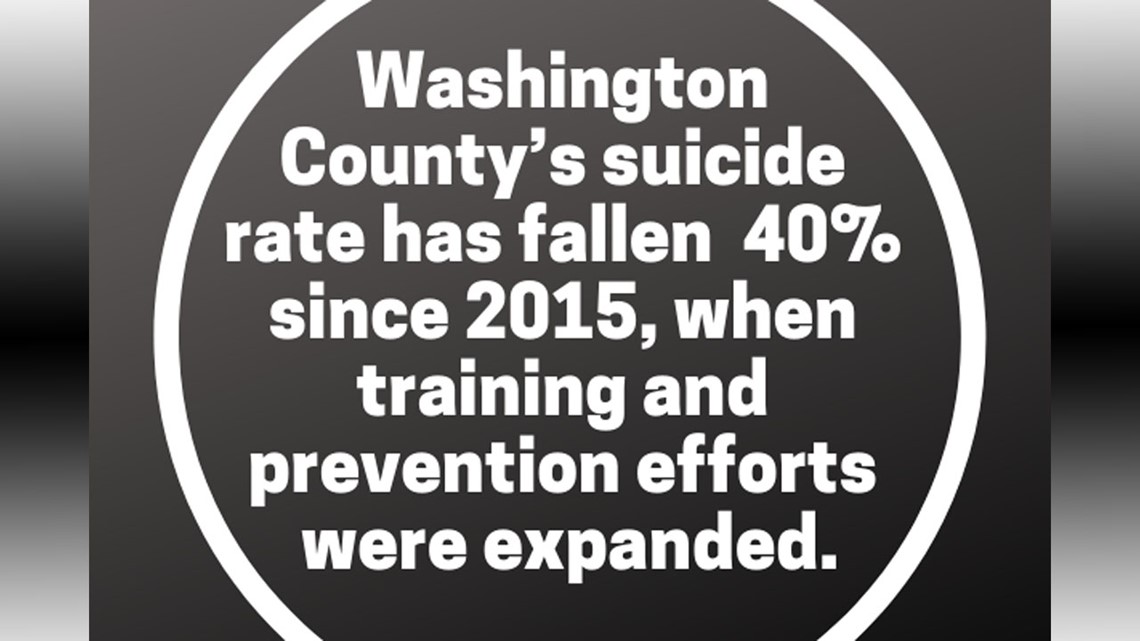
__________
Oregon has one of the highest suicide rates in the nation, ranking 14 out of 50.
The rate of suicide among Oregonians has increased by 35 percent between 2000 and 2017. In 2017, 825 Oregon residents died by suicide, according to the Oregon Health Authority.
For all ages, suicide is the eighth-leading cause of death among Oregonians. For Oregonians ages 10 to 34, it is the second-leading cause.
Approximately 1 percent of suicides – roughly five to 10 people a year – are associated with eviction or the loss of a home.
Evictions are stressful, especially to low-income people who do not necessarily have money saved to pay for moving costs, a security deposit and first and last month’s rent.
If someone is forcibly removed from their home as the result of an eviction, which happens to about 1 percent of the Oregon population each year, it caps off, at times, months of worry and stress about the loss of one’s home.
People are most often evicted due to nonpayment of rent, for illegal acts on the rental property, or for continuous or recurring problems, such as with a pet or loud noises.
But Oregon also allows no-cause evictions, which means that a landlord can give a renter a notice to move without providing any reason.
In Portland, due to reforms passed in 2015, renters who are given eviction notices must now be given 90 days’ notice to move.
For the vast majority of cases, a landlord can simply send the renter an eviction and the renter moves. Or, in cases of nonpayment or compliance issues, the landlord and the renter make arrangements to solve the problem.
But in cases where that does not happen, a landlord can file the eviction in court and pursue a court order to legally require the renter to move. A renter can challenge the eviction in court to have the eviction revoked or the move-out date changed.
If the court sides with the lawyer, the renter can then be removed from the property. A notice is then attached to the front door of the rental, stating the move-out date.
From that point, the process only becomes more stressful and harried for renters. Renters have four days to move. If they do not, sheriff’s deputies can go onto the property and forcibly remove the person, giving them only a few minutes to collect some belongings. It is typical, from that point, for the renter to be locked out of the home and to be allowed to retrieve their belongings only with a sheriff’s deputy present.
Lavar Edmonds is a sociologist and researcher at the Eviction Lab, which is based at Princeton University and maintains the first national database of evictions, with records of eviction dating back to 2000.
He argues against a “dangerous assumption” that once someone is evicted, they simply find another place to live.
“That’s not necessarily how it works,” he said, noting that an eviction is on a person’s court record and will show up on any background check that a future landlord makes. Oftentimes, he said, people who are evicted move into more substandard housing or become homeless.
“Homelessness is not much of a leap in mind,” he said, since many renters are forcibly evicted because of not paying the rent.
The Eviction Lab and the work of its founder, Matthew Desmond, author of the Pulitzer Prize-winning book “Evicted,” has raised awareness of eviction as a dire social problem in the past few years. Desmond’s research has shown clear links between eviction and increased rates of stress, depression, anxiety and other mental illnesses for up to two years after being evicted.
The first comprehensive study analyzing eviction as a risk factor for suicide was published in a 2015 study in the American Journal of Public Health.
The study used data collected by the National Violent Death Reporting System, a surveillance system that tracks data related to violent deaths, including suicide, to examine suicides that took place from 2005 to 2010, during the Great Recession and during years when there were record numbers of foreclosures and evictions.
The researchers identified 929 suicides that had eviction and foreclosure as the precipitating event leading to the death. The researchers also found that the number of suicides with eviction or foreclosure as a risk factor doubled between 2005 and 2010.
Nearly 80 percent of the suicides took place before the person actually lost their housing, and 37 percent of people had experienced eviction or foreclosure within two weeks of their deaths. One of the main conclusions of the study is that during times of economic crisis, suicide prevention measures need to be increased.
The findings are mirrored by a Swedish study, published in 2016 in the Journal of Epidemiology and Community Health, which examined whether people who faced eviction were more likely to die by suicide than those who did not.
The study compared the rates of suicide among 22,000 Swedish households that were evicted between 2009 and 2012, compared to a random sample of 10 percent of the Swedish population. The researchers also controlled for numerous socio-economic and demographic factors often considered risk factors for suicide, including mental illness and drug abuse.
The study found that people who were evicted were four times more likely to die by suicide than people who were not.
“Our results reinforce the importance of ongoing attempts to remove the issue of evictions from its status as a hidden and neglected social problem,” the researchers wrote.

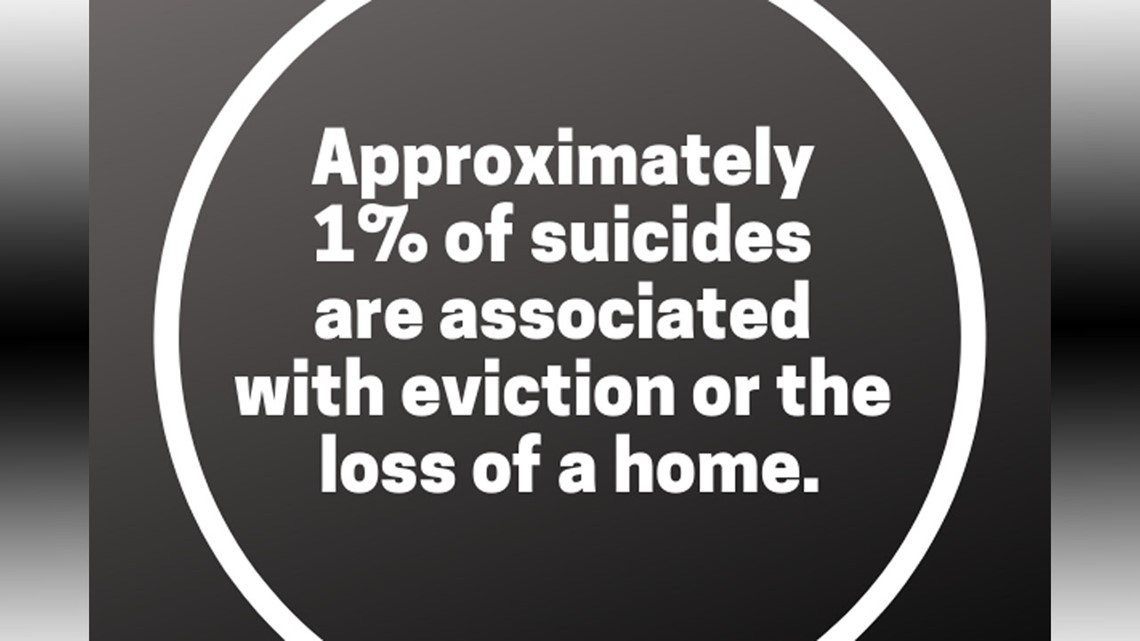
__________
Deborah Zwetchkenbaum is the assistant director of the crisis line that is operated by Lines for Life, a Portland nonprofit that works to prevent suicide. The crisis line fields more than 25,000 calls each year from people who have thoughts of suicide, are depressed, or are having problems that lead to thoughts of suicide.
Zwetchkenbaum said she has “done a lot of work on the phone” and estimated that approximately one out of 10 people call the crisis line due to eviction or the threat of eviction, homelessness or housing instability.
“The fear of losing your housing is definitely something that I’ve heard a lot,” she said. “The fear of becoming houseless can really get people to the point where they’re just like, ‘I’m not going to do that. I would rather die than become houseless.’”
In 2018, more than 2 percent of calls – 1,335 out of 41,145 – came from people who explicitly stated that homelessness was the primary stressor in their lives.
Those numbers do not include people experiencing housing instability – people who fear they will lose their home or are about to. It also does not include people who say they are couch surfing. Lines for Life does not collect and isolate that data.
Zwetchkenbaum said the people who call the crisis line are a self-selecting group of people, meaning that the numbers of people who are actually homeless and having thoughts of suicide is, in all likelihood, much higher.

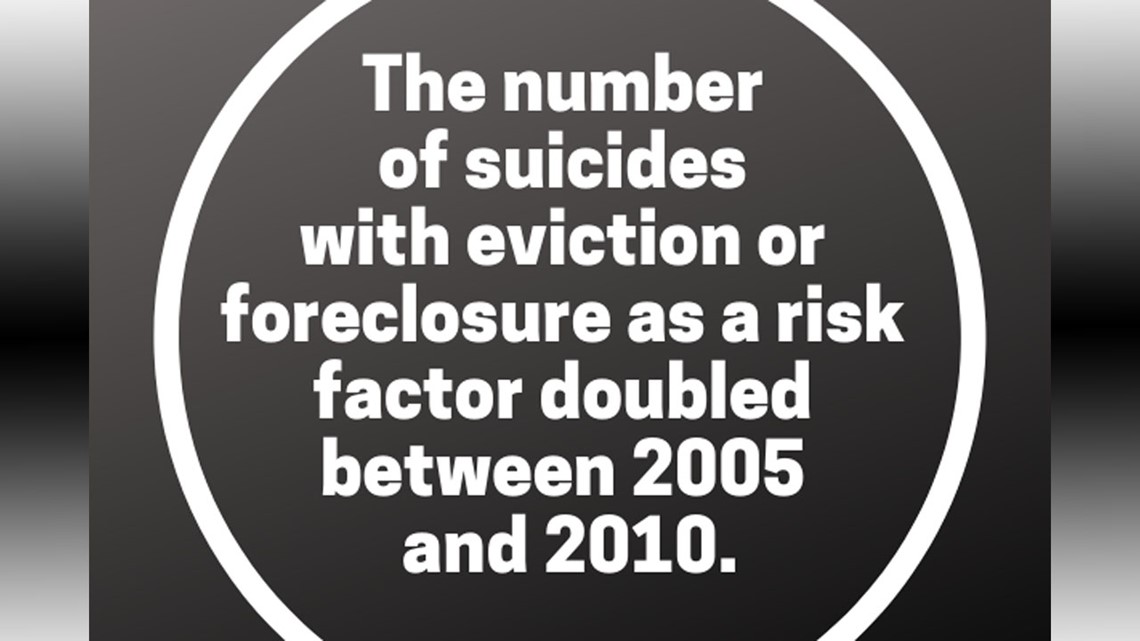
__________
“Of course there is a connection between eviction and suicide,” said Margot Black, an organizer with Portland Tenants United, a tenants activist organization.
Black said she regularly talks with renters who experience “sleepless nights, crushing anxiety and deep depression” due to fear of being evicted. Eviction can be especially stressful to people who have lived in their home a long time, she said, or are attached to their home.
If a renter is already experiencing problems with personal finances, mental or physical health, family, or other issues, an eviction can cause “a perfect storm to increase all the stressors that would make someone vulnerable to a mental health crisis,” Black said.
In the Portland area, the link between eviction and suicide has become more and more apparent in recent years.
In January 2016, a town hall was held to discuss the increase in homelessness and the lack of affordable housing in the Portland area, a crisis that had quickly burgeoned in Portland that year.
Nearly every state representative and senator representing the Portland area attended, as did then-mayoral candidate Ted Wheeler.
The purpose of the town hall was to educate legislators about the housing crisis and to inform potential legislation and policy. Hundreds attended, and the room, at the Immigrant & Refugee Community Organization’s Northeast Portland headquarters, was packed to standing room only.
Marissa Madrigal, Multnomah County’s chief operating officer, told a story about her friend Paul.
Paul lived in a small, dark basement apartment with his cat. It was not much, Madrigal said, but “he had carved out a safe home after many, many different struggles.”
He had lived there, near Southeast Hawthorne Boulevard, for 10 years. The apartment had problems with mold, so he told his landlord and asked that repairs be made. The landlord gave Paul a no-cause eviction.
Madrigal helped him get a lawyer. The apartment’s air was tested. She and other friends helped him as much as they could. They made a plan for Paul to stay at another friend’s in case he had to move.
As long as someone checked on him, Madrigal told Street Roots, “there was an outlet” for him to manage the stress and feel that things would be OK.
Their efforts were unsuccessful. The day before he had to move out, Madrigal said, the landlord posted another eviction notice on the door.
He died by suicide the next day.
“The struggle and the pain of it just wore him down,” Madrigal said.
“This is a life and death issue,” Madrigal said, speaking about eviction during the town hall. “This is not just an annoyance or an inconvenience.”
In April 2016, months after Madrigal told that story, Gregory Zagel was confronted by the Clackamas County Sheriff’s Office and the county’s SWAT team as they attempted to forcibly evict him from his apartment.
Zagel had lived in his apartment, in the Oswego Pointe complex in Lake Oswego, for more than 14 years, according to a Portland Tribune article detailing the circumstances leading to Zagel’s death.
Zagel, who was 61, received a no-cause eviction in October 2015, stating that he had to move by Dec. 8. He challenged it in court, and a hearing took place in Clackamas County Court on Dec. 18.
During the hearing, he admitted he knew he had to move. He then alluded to the pressures many poor renters are suddenly faced with when they receive evictions.
“It’s hard to relocate when you have basically no money,” Zagel said. “This is the first time I’ve had to worry about a roof over my head. And to be honest, it’s tearing me up. I never thought I’d be in a position like this.”
The deadline for Zagel to move was pushed to Jan. 5. But he didn’t move out. On Tuesday, April 19, sheriff’s deputies arrived to remove him. Armed with a gun, Zagel fired a shot into the floor of his apartment and barricaded the door.
Two days later, he took his life.

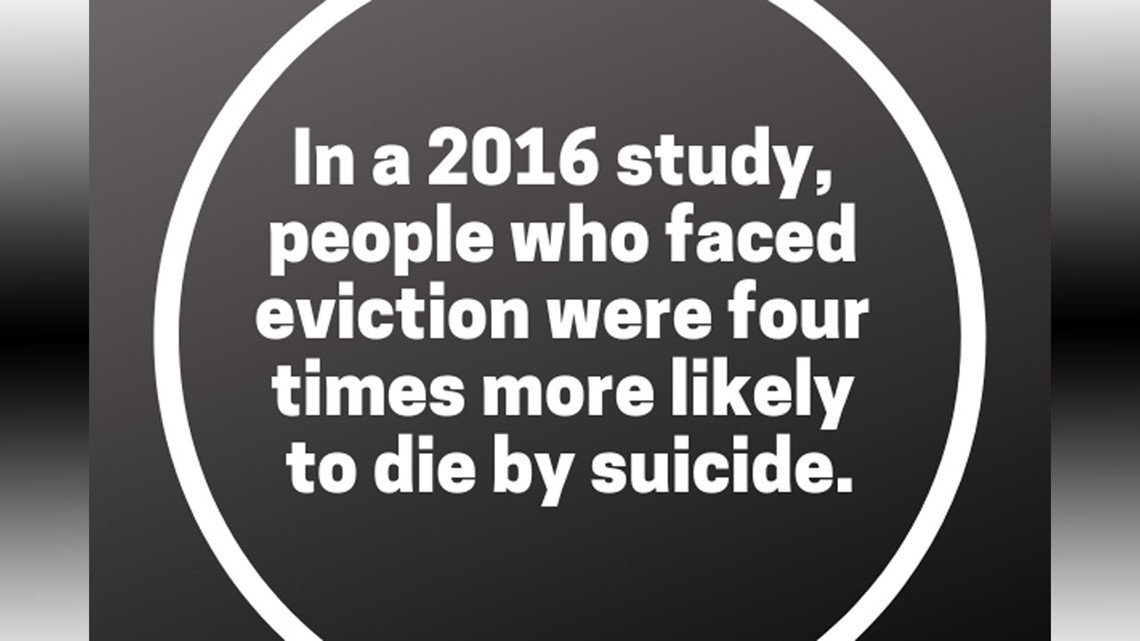
__________
When Repp accompanied Lovato on death scene investigations, she said that she could “feel the suffering” in the rooms where people ended their lives.
People often left eviction papers on their dining room or coffee tables – out in the open, where anyone could see them, as if the person had just set them there.
In some cases, the papers were still nailed to the front door.
As a result of Repp’s efforts, Washington County can now isolate the main risk factors that can contribute to someone’s death by suicide.
Repp emphasizes that there is not a single reason that someone can identify to say why someone died by suicide, including eviction.
“It’s an oversimplification to suggest that one risk would cause one to end their life,” she said. “It’s a lifetime culmination of experiences that lead there.”
Repp’s data shows that depression, physical health problems, social isolation and a crisis that took place within the last two weeks – which includes eviction – are the most prevalent risk factors for suicide in Washington County.
That data allows Repp and others to isolate places people thinking of suicide frequent. For example, the data shows that many people, within two weeks of dying by suicide, will take their pets to an animal shelter. Staff at the county Humane Society locations have received suicide prevention training, as have the staff at a Budget Hotel where a number of people died by suicide.
Repp’s data also shows that people will see their doctor within two weeks of dying – an example, Repp suspects, of how people stick to their normal routine. She is now working with hospitals and doctors’ offices to screen for suicide.
A cornerstone of those trainings is what is known as “QPR,” which stands for “question, persuade and refer.” People are trained to ask someone, point blank, if they have thoughts of harming themselves, and then to persuade someone who is having those thoughts to think of people in their lives who can help and of parts of their life to be grateful for or to look forward to. Trainees are then given resources they can refer people to for further help.
Repp hopes to offer the training to landlords and managers of large apartment complexes throughout Washington County.
Since the county’s suicide intervention efforts began in 2015, about five deaths with eviction as a risk factor have been prevented each year.
“It could be life-threatening bad news,” Repp said of eviction. “If putting a piece of paper (in eviction paperwork) saves even one life, we’re going to do it. It could mean the difference between life and death to someone.”
From time to time, she receives a phone call from someone. They rarely give a first name. They call to thank her, to say that they are still alive due to her efforts.
“It’s happened multiple times,” she said. “It’s hard to get a positive response to public health work during your lifetime. It’s profound.”
__________
RELATED:
The National Suicide Prevention Lifeline can be reached at 800-273-8255. The Crisis Text Line provides free, 24/7 crisis support by text. Text 741741 to be connected to a trained counselor.
Help is available for community members struggling from a mental health crisis or suicidal thoughts. Suicide is preventable.
The Multnomah County Mental Health Call Center is available 24 hours a day at 503-988-4888.
If you or someone you know needs help with suicidal thoughts or is otherwise in an immediate mental health crisis, please visit Cascadia or call 503-963-2575. Cascadia Behavioral Healthcare has an urgent walk-in clinic, open from 7 a.m. to 10:30 p.m., 7 days a week. Payment is not necessary.
Information about the Portland Police Bureau's Behavioral Health Unit (BHU) and additional resources can be found by visiting http://portlandoregon.gov/police/bhu

